[soliloquy id="10009"]
Call Today! 978-494-4973
Inground pool buyers guide | New Hampshire | The size, shape and materials of an inground pool make a big difference in the overall cost. Kayak pools can be purchased at a fraction of cost of a fully installed in ground pool.
While pool costs vary on elements such as size additions, water features, enclosures, and deck and patio design, you must also consider factors such as quality of workmanship and design, strength, ease of maintenance, warranty and service. The size, shape and materials will also make a big difference. That being said, an in-ground pool can be purchased and installed for around $25,000 – $60,000.
If that’s in your budget then you’re in the right spot, see below for all the information you’ll need to choose the in-ground pool of your dreams:
Call Today! 978-494-4973
[soliloquy slug=”kayak-swimming-pools-new-hampshire”]
First Steps: Planning:
Planning is the most important part of any pool project: swimming pools vary in size and shape, but it’s important that the size of your yard meets the requirements for your pool design. This saves many headaches later on.
Shallow pools with a max depth of 4 to 5 feet are becoming quite popular. These pools are great for water sports (water polo, basketball, volleyball, etc.). If you want to be able to dive, you’ll need a pool of at least 8 feet – contact your pool builder and manufacturer for complete safety information on pool diving.
Pool designs are making it easier than ever to blend your pool into the landscaping of your yard. Naturally shaped pools made to look like outdoor ponds and other “free-form” pools, easily lend themselves to your landscaping. Or you can always stick with the classic rectangle, square and oval shapes, which never go out of style.
- Pool Shapes:
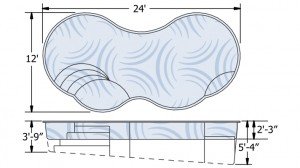
Choosing Your Materials:
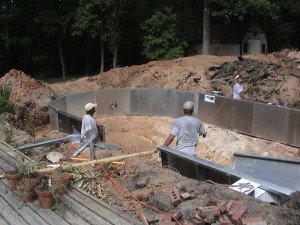
Shapes and materials go hand in hand. Some shapes can only be produced using Vinyl liners. Understanding the differences, both in construction and price, is the next step to building the pool of your dreams!
Vinyl:
Vinyl lined pools have helped to reduce the cost of pool construction. That’s because pools are built with prefabricated metal/steel or plastic frames that are set into a pre dug hole and reinforced with concrete footings and wall braces. The easy assembly makes these pools less costly – nearly half the price of a concrete pool! There are a number of “standard” sizes and shapes available, and builders are able to do custom designs as well.
Learn more about Inground pool buyers guide | New Hampshire Kayak Pools:
- Vinyl pool shapes
- Liner Collection
Fiberglass:
You may have seen fiberglass pool shells; we have a few sitting outside our showrooms. They are made in the shape of of the pool and delivered to the jobsite in one piece, then lowered into the ground by a crane.
Pricing of a fiberglass pool is usually 30-40% higher than vinyl pools, but over time require less maintenance, reducing the overall exceptional cost of your pool.
Learn more about Inground pool buyers guide | New Hampshire:
- Fiberglass pool shapes
Concrete:
Instead of using liners, Concrete pools use a combination of concrete and plaster. Excavation of the property is necessary, but these pools provide a wide variety of creative options – from waterfalls to custom steps. These pools are usually at the highest end of the pool price range.
Due to the custom nature of these pools, it can often take 60-90 days to build. Most Concrete pool projects start at 40,000.
Learn more about Inground pool buyers guide | New Hampshire:
- Concrete pools
- Low Maintenance
- Speed of Installation
- Low Chemical Usage
- Smoothness of Finish
- Durability
- Low exceptional cost
- Energy Efficiency
- Attractive & Elegant
- Low initial cost
- Custom Shape & Size
- Shape & depth limitations
Pumps:
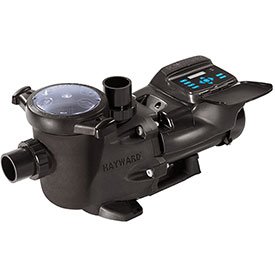 The pump is the lifeblood of your swimming pool’s filtration equipment. Its job is to pull water from the main drain and skimmer and circulate it through a filter for cleaning. The water is then returned to the pool via return lines or jets.
The pump is the lifeblood of your swimming pool’s filtration equipment. Its job is to pull water from the main drain and skimmer and circulate it through a filter for cleaning. The water is then returned to the pool via return lines or jets.
Pumps come in various sizes and horsepowers. Choosing the right one depends on a number of factors such as total pool gallons, plumbing (the size of pipes, number of intakes and quantity and types of fittings), turnover requirements (the ability to circulate the entire body of water through the filtration system at least once a day), and the square footage of the pool itself.
There is a detailed hydraulic formula for calculating a properly sized pump (and filter) for every shaped pool. Some builders ignore this formula because they don’t understand it or haven’t taken the time to learn it. Instead they “guess,” which often results in improperly sized equipment, higher energy costs to the owner, and reduced life expectancy for the pump.
Inground pool buyers guide | New Hampshire.
Filters:
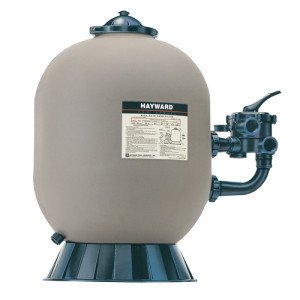
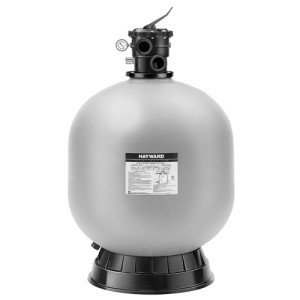
You have three filters to ensure clean, clear water:
Sand Filters:
The oldest and most popular, pool water is routed through a sand or mineral filled pressure vessel. Over time, dirt accumulates in the spaces between the sand particles causing the pressure in the vessel to rise as water finds it harder to pass through. You can then “backwash” the filter into a waste line, cleaning the sand.
Diatomaceous earth (D.E.) Filters:
These filters contain special internal cloth elements coated with D.E., a porous powder with microscopic openings that, when magnified, look a lot like tiny sponges. Clear water can pass through these openings, but particles as small as one to three microns are trapped during the first pass through the media. These are also cleaned by “backwashing” the filter into a waste line.
Cartridge filters:
Cartridge filters are similar to the oil filter in your car, water simply passes through the pleated filter material. Dirt and contaminants are trapped there. After prolonged intervals, the filters are removed, pressure washed with a garden hose, and replaced.
Drains:
For maximum safety and optimal cleaning, Kayak Pools includes two main drains and skimmers as standard equipment on your pool package.
This way, if something or someone blocks one drain, the pump will pull water from the other drain, while eliminating the suction on the blocked drain.
Heaters:
Adding a heater to your in-ground pool can extend the swimming season by at least two months in both the spring and fall. You have two options for pool heaters:
- Electric heat pumps.
- Natural Gas or Liquid Propane Fuel.
- Solar .
Ask us which type of pool or spa heater is best suited for your application.
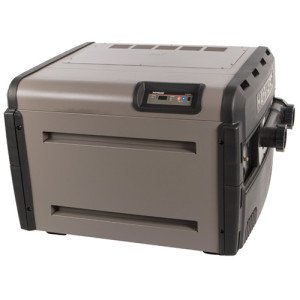
Lighting
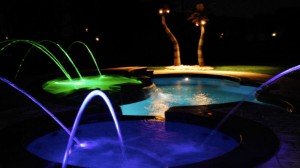
Nothing sets the mood like good lighting. Your pool can create a tranquil setting for relaxing or entertaining.
Underwater lighting really brings out the beauty of your pool. Apart from creating a safe nighttime swimming environment, underwater lighting also allows you to create an atmosphere for your pool that can quickly change to suit any mood.
With the new fiber optics and color-changing LED lights available, you can enjoy a festive and exciting underwater light show right in your own back yard.
Pool Covers:
A pool safety cover can provide added peace of mind. Do not confuse safety covers with other pool covers which are used to save energy (solar covers) and keep debris out of the pool. Regardless of the type of cover you choose, there are automatic and manual models. Consult with our representatives for the type and model that best meets your particular needs. For safe installation, use and maintenance of these covers, carefully read and follow the directions from the manufacturer.
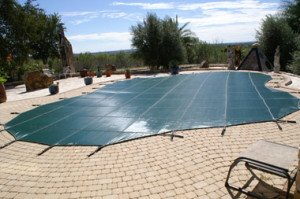
Fencing:
One of the questions we are most often asked is, do I need a fence around my pool? The answer is yes. All pools require a minimum 4-foot high fence surrounding the pool area. Make sure the fence you install has a self closing and self latching gate.
Besides being an important safety feature, fencing can be used in many creative ways around your pool. Such uses include, but are not limited to:
- Separating your pool area from a neighbor’s property.
- Create a special pool area, apart from swings, slides and other playground equipment.
- An attractive fence can camouflage your pool equipment.
- Enclose a separate spa or sauna area.
- Privacy for family and friends.
You can get pretty creative here. Make sure to get advice from a landscape architect or fencing contractor, to help you decide which fence type will suit your visual and functional needs. Equally important during the construction of a new swimming pool is temporary fencing.
Maintenance Devices:
Automatic pool cleaners can clean the entire pool interior. These busy little helpers clean the pool bottom and walls of your pool… automatically, so your pool is kept sparkling clean, day after day, year after year.
There are three types of pool cleaners:
- Pressure-side cleaners – operate off a separate booster pump, working independently from the pool’s primary filtration equipment. Dirt and debris are channeled into the cleaner’s unique filter bag before it reaches the pump basket or filter.
- Suction cleaners – operate off the pool’s existing filtration system, vacuuming and then depositing debris into the pump and skimmer baskets or filter. Depending on the debris in the pool, these cleaners will require more frequent cleaning of the pump and filter in order to operate and clean at full capacity.
- Electric Cleaner – plug into a standard grounded electrical outlet equipped with approved ground fault circuit interrupter (GFCI outlet). They operate independently of a pool or auxiliary pump while depositing dirt into a self contained filter or separate debris bag.
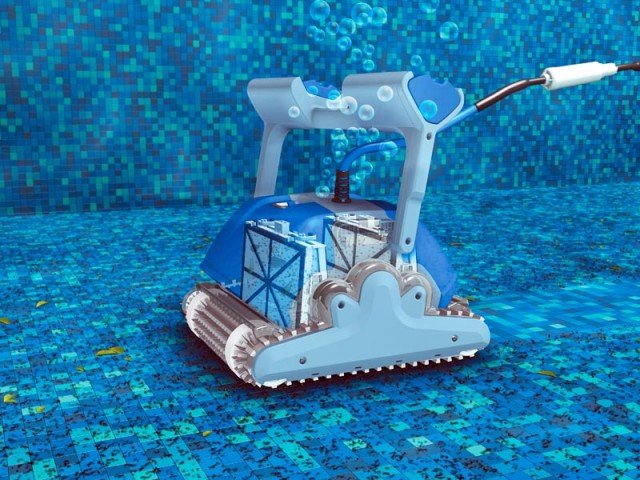
Chemicals:
Adding and maintaining pool chemicals is easy thanks to automatic chlorine generators. These high tech devices manufacture chlorine from salt that’s added to your pool periodically. Chlorinating your pool is as easy as pushing a button. You can also manually sanitize your water via chemicals feeders that can distribute chlorine and other forms of sanitizer at present intervals as needed.
Mineral purifiers naturally sanitize the water while keeping the amount of chemical additives to a minimum, saving time and money.
5 types of pool treatment systems:
- Chlorine: most common type of cleaning system.
- Frog: Mineral based system that helps reduce amount of needed chlorine.
- Nature 2 – Mineral based system that can be combined with salt water systems.
- Salt System – creates chlorine from salt for a less chemical swimming experience.
- Baquacil – Chlorine-free system that is less irritating to eyes and easier on pool liners.
Spas:
Options and add-on for hot tubs & spas include: stereo systems, TV screens, DVD players and colored lights.
Landscaping:
Landscaping your pool area really adds to the ambience of pool ownership. You can create a place of beauty, safety, privacy and convenience. Although you may not be in a position to do everything you want at once, that’s okay. By all means go ahead and create a landscape design to fulfill all your dreams of the perfect backyard. Once you have a master plan, you can add in stages. Start small and work your way up. During the design process, we are happy to give you some ideas or refer you to a landscape architect.
Privacy is usually a concern and should incorporate various design elements such as trees, walls, fences, screen, shrubs, gardens or whatever you like that accomplishes your goal.
Comfort is also important. Do you like lots of sun? Maybe you’d prefer to have a shady area by the pool for lounging or reading. Consider how you will entertain at poolside. Will it be parties, family gatherings, barbecues? Long term planning is important for a successful project.
Blending the landscape elements to take in both your home design and pool area, you can achieve a harmonious balance for your backyard pool environment. Talk to professional landscapers and garden design experts for ideas, but don’t forget to include us in the conversation when exploring your ideas. Your plan may include a change or radical design in pool shape and size.
Deck and Patio:
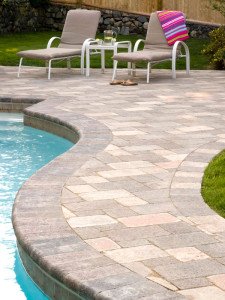
You may decide to surround your pool with any number of materials. Some of the more common designs include concrete decking (both broom finish and stamped), brick, wooden decking, paving stones, fieldstone and porcelain outdoor tile.
You may include a path or walkway linking other areas of your yard. These are both aesthetically pleasing and practical. These design materials add usable space and functionality to your pool area. They allow for drainage, ground cover and eye appeal. Undoubtedly you will find many landscaping design books. These books are filled with wonderful ideas and may inspire you to create your own layout.
Furniture:
Of course you’ll want to think about outdoor furniture for relaxing by the pool. Possibly lounge chairs and umbrellas to create shaded areas when you need them. Maybe include children-sized seating for your youngest family members and friends.
Your main goal here should be balance, variety, proportion and overall aesthetics.
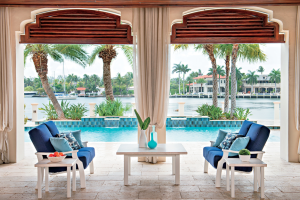
Safety:
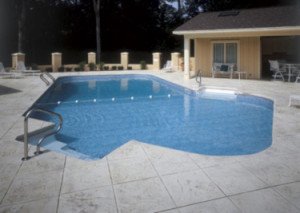
Nothing is more important for your pool projects than safety. Supervision is a key element in getting maximum, safe enjoyment from a pool. Children should never be left alone in or near a pool, spa, or any body of water. While layers of protection such as a fence, wall or natural barrier around a pool can help protect children under the age of five and other unauthorized users, there is no substitute for adult supervision.
Pools should never be used by anyone under the influence of alcohol or drugs. Before jumping into a pool, users should know the depth of the water and look out for any submerged obstacles, surface objects or other swimmers. Jumping incorrectly into shallow water can be dangerous, and injuries, such as a broken leg, can occur if you hit bottom with sufficient force. If you want a pool that you can dive into, make sure it is designed specifically for diving and meets all standards as specified by the Association of Pool and Spa Professionals, ANSI Standards and Consumer Safety board regulations. You can learn more about these regulations by clicking the links below:
